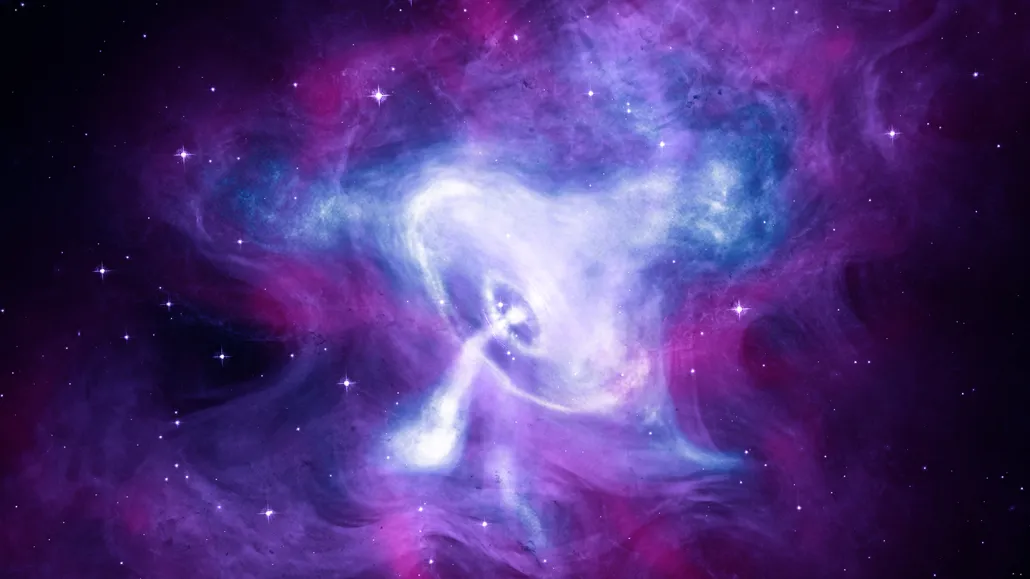
Pulsar wind nebulas, such as one in the Crab Nebula (pictured), may be responsible for boosting cosmic rays, specifically electrons, to ultrahigh energies. That boosting process can create gamma rays with the highest energies ever detected. In this composite image, X-rays are blue, visible light is purple and infrared radiation is magenta.
X-ray: CXC/SAO/NASA; Optical: STScI/NASA; Infrared: JPL-Caltech/NASA
The windy and chaotic remains surrounding recently exploded stars may be launching the fastest particles in the universe.
Highly magnetic neutron stars known as pulsars whip up a fast and strong magnetic wind. When charged particles, specifically electrons, get caught in those turbulent conditions, they can be boosted to extreme energies, astrophysicists report April 28 in the Astrophysical Journal Letters. What’s more, those zippy electrons can then go on to boost some ambient light to equally extreme energies, possibly creating the very high-energy gamma-ray photons that led astronomers to detect these particle launchers in the first place.
“This is the first step in exploring the connection between the pulsars and the ultrahigh-energy emissions,” says astrophysicist Ke Fang of the University of Wisconsin, Madison, who was not involved in this new work.
Last year, researchers with the Large High Altitude Air Shower Observatory, or LHAASO, in China announced the discovery of the highest-energy gamma rays ever detected, up to 1.4 quadrillion electron volts (SN: 2/2/21). That’s roughly 100 times as energetic as the highest energies achievable with the world’s premier particle accelerator, the Large Hadron Collider near Geneva. Identifying what’s causing these and other extremely high-energy gamma rays could point, literally, to the locations of cosmic rays — the zippy protons, heavier atomic nuclei and electrons that bombard Earth from locales beyond our solar system.
Sign up for our newsletter
We summarize the week's scientific breakthroughs every Thursday.
Some gamma rays are thought to originate in the same environs as cosmic rays. One way they’re produced is that cosmic rays, shortly after being launched, can slam into relatively low-energy ambient photons, boosting them to high-energy gamma rays. But the electrically charged cosmic rays are buffeted by galactic magnetic fields, which means they don’t travel in a straight line, thus complicating efforts to trace the zippy particles back to their source. Gamma rays, however, are impervious to magnetic fields, so astrophysicists can trace their unwavering paths back to their origins — and figure out where cosmic rays are created.
To that end, the LHAASO team traced the hundreds of gamma-ray photons that it detected to 12 spots on the sky. While the team identified one spot as the Crab Nebula, the remnant of a supernova about 6,500 light-years from Earth, the researchers suggested that the rest could be associated with other sites of stellar explosions or even young massive star clusters (SN: 6/24/19).
In the new study, astrophysicist Emma de Oña Wilhelmi and colleagues zeroed in one of those possible points of origin: pulsar wind nebulas, the clouds of turbulence and charged particles surrounding a pulsar. The researchers weren’t convinced such locales could create such high-energy particles and light, so they set out to show through calculations that pulsar wind nebulas weren’t the sources of extreme gamma rays. “But to our surprise, we saw at the very extreme conditions, you can explain all the sources [that LHAASO saw],” says de Oña Wilhelmi, of the German Electron Synchrotron in Hamburg.
The young pulsars at the heart of these nebulas — no more than 200,000 years old — can provide all that oomph because of their ultrastrong magnetic fields, which create a turbulent magnetic bubble called a magnetosphere.
Any charged particles moving in an intense magnetic field get accelerated, says de Oña Wilhelmi. That’s how the Large Hadron Collider boosts particles to extreme energies (SN: 4/22/22). A pulsar-powered accelerator, though, can boost particles to even higher energies, the team calculates. That’s because the electrons escape the pulsar’s magnetosphere and meet up with the material and magnetic fields from the stellar explosion that created the pulsar. These magnetic fields can further accelerate the electrons to even higher energies, the team finds, and if those electrons slam into ambient photons, they can boost those particles of light to ultrahigh energies, turning them into gamma rays.
“Pulsars are definitely very powerful accelerators,” Fang says, with “several places where particle acceleration can happen.”
And that could lead to a bit of confusion. Gamma-ray telescopes have pretty fuzzy vision. For example, LHASSO can make out details only as small as about half the size of the full moon. So the gamma-ray sources that the telescope detected look like blobs or bubbles, says de Oña Wilhelmi. There could be multiple energetic sources within those blobs, unresolved to current observatories.
“With better angular resolution and better sensitivity, we should be able to identify what [and] where the accelerator is,” she says. A few future observatories — such as the Cherenkov Telescope Array and the Southern Wide-field Gamma-ray Observatory — could help, but they’re several years out.







